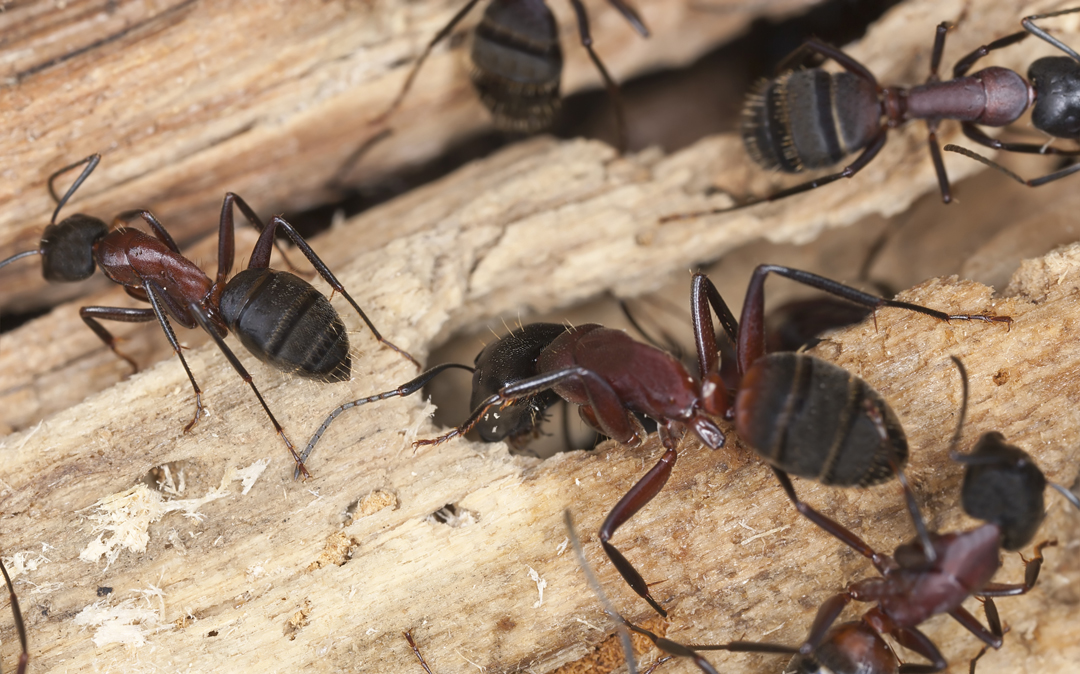Helpful Tips On Managing and Preventing Carpenter Ants
 When we generally think of ants, it’s easy to picture these tiny insects emerging from a little mound in the dirt to steal our picnic food. But with over 12,000 different species of this colonial creature across the globe, some types of ants can ruin more than just the family outing. One of those unsuspecting species is the carpenter ant. This kind of ant is known to cause severe structural damage to homes and other wood structures. People can be unaware of their presence in a structure until it’s too late. In this article, the Kness Pest Defense Team will cover ways in which you can identify, control, and prevent a carpenter ant infestation.
When we generally think of ants, it’s easy to picture these tiny insects emerging from a little mound in the dirt to steal our picnic food. But with over 12,000 different species of this colonial creature across the globe, some types of ants can ruin more than just the family outing. One of those unsuspecting species is the carpenter ant. This kind of ant is known to cause severe structural damage to homes and other wood structures. People can be unaware of their presence in a structure until it’s too late. In this article, the Kness Pest Defense Team will cover ways in which you can identify, control, and prevent a carpenter ant infestation.
Carpenter Ant Characteristics
Carpenter ants are named for their ability to build nests, or galleries, in wood. They don’t eat wood. Instead, the ants bore very smooth tunnels in timber by chewing away wood fibers and moving it out of the nesting area. The diet of carpenter ants consists of meats, fats, other insects, and sugary foods. You can identify them by looking for the following characteristics:
On average, over a half-inch (5/8”) in size
Oval shape
Have six legs
Antenna that extends from the head at a 90-degree angle
Red or black coloring
Some will have narrow wings
Signs of An Infestation
As mentioned before, these insects specialize in wood tunneling. This leaves conventional homes and other wood buildings vulnerable. Carpenter ants prefer to infest wood that has been exposed to or weakened by fungus and moisture. Due to walls covering the structure of a house, it can be difficult for homeowners to realize there is an infestation.
There are some visual indications that a carpenter ant nest has been established in a home. The gallery’s worker ants and winged ants (known as Swarmers) will begin entering the home through small gaps wood surfaces, such as windows frames, doors, and baseboards. They do this in search of food or to move excavated wood from their nest. If you notice the random appearance of sawdust-like material near interior baseboards or piles close to the outside foundation, a nest has been created. Nests are common in wall voids where water leaks have damaged wood in window frames, doors, behind sinks, showers, and the dishwasher.
If you suspect that these ants are in your home, you can try to locate the nest by using a blunt object, like a rubber mallet or handle of a tool, and tap on the wall to listen for the sound of hollow wood. Tapping on the wall near a nest will also cause the ants to respond defensively by making a rustling sound. However, carpenter ants coming into the home doesn’t always mean there is a nest in the structure.
Nests can be found in areas outside of the home. Trees, wood mulch, firewood piles, and other rotting wood material nearby could be the real source of the colony. Firewood is a particular favorite of this ant species. So be sure to keep an eye out if you suspect an infestation.
Control Methods
Carpenter ants can be challenging to get rid of once they are established. The best way to get rid of them is to locate and destroy the nest. You can attempt to do this on your own or consult a pest professional. When doing it yourself, there is a range of over-the-counter baits and products that you can use to gradually reduce the population.
One solution is the Kness Ants-No-More® Bait Station. This specially designed bait station works by attracting foraging ants to take the bait back to the colony and eliminating them at their source. Ants-No-More can be placed indoors and outdoors.
Other control methods include replacing any structurally damaged wood. For significant ant problems, pest management specialists have access to professional-grade insecticides that can be used to treat the problem.
Prevention
To help reduce the chances that carpenter ants won’t infest your place of home or business, be sure to practice the following:
Eliminate any moisture problems, roof leaks, and plumbing leaks. Remove areas of standing water around the property as well.
Replace damaged or moist wood that has been identified in the structure.
If there are any trees near your house, cut back tree limbs or branches that can be used as a bridge to your home.
Seal cracks or openings around the foundation that could serve as an entry point for the ants. Utility pipe and wire entrances into the home should be properly sealed as well.
Remove excess soil or mulch that has been pushed up against the side of a home. This creates a barrier where it is less desirable for carpenter ants to cross over to your home.
If you have a wood scrap pile or firewood, move it away several feet away from the house and keep it elevated. Firewood is a favorite of carpenter ants to make nests.
Continue utilizing the Ants-No-More Bait Station around in and around the home or business to eliminate ants as they forage.
Visit our Pest Control Center for more pest prevention tips.